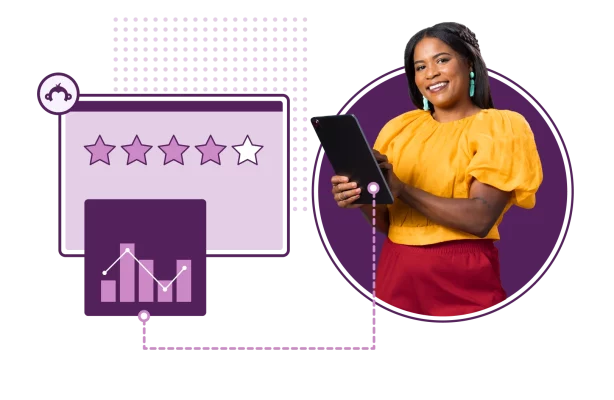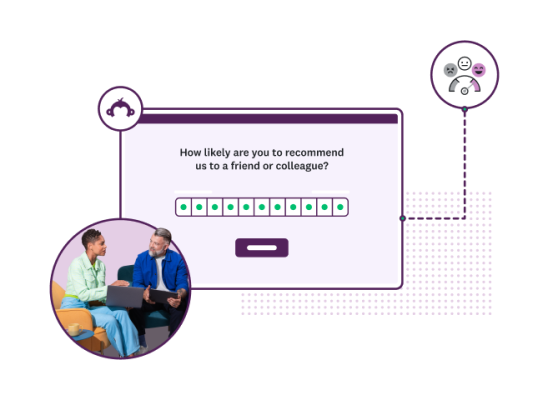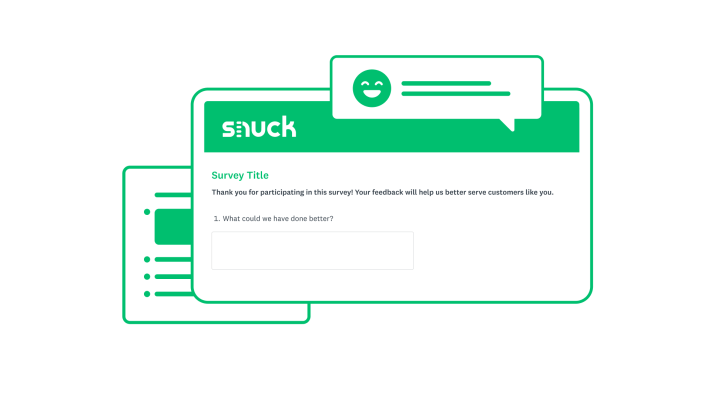NPS surveys: Best practices for high response rates

The Net Promoter Score® (NPS) quantifies customer satisfaction and loyalty. This simple metric reveals how likely customers are to recommend your business. By analyzing NPS data, companies can pinpoint areas for improvement in their customer experience. Acting on these insights often leads to increased customer retention, higher sales, and improved profitability.
However, you can't realize the benefits of NPS unless you achieve high response rates. A robust sample size ensures more accurate and actionable insights. There are several effective strategies that can boost participation, which we'll go over.
How to increase NPS survey response rates
Businesses should prioritize increasing response rates for all customer experience (CX) surveys, especially NPS. A high response rate provides a more accurate and comprehensive picture of customer satisfaction, ensuring the integrity and reliability of your score. Conversely, low participation can skew results and lead to misguided business decisions. To boost response rates, consider strategies such as personalizing invitations, offering incentives, and optimizing survey timing and length.
Several other factors can influence your response rate:
- Your company’s industry
- The method you use to distribute your NPS survey
- When you send the survey
- The actions that trigger you to send the survey
A good NPS will vary depending on the industry you work in. SurveyMonkey data demonstrates that the global average is around +32, but this will vary depending on your industry. You can calculate your NPS score using our calculator
You should continuously record NPS data to set your business up for success. Producing an effective NPS survey, distributing it through appropriate channels, and setting success benchmarks will help increase response rates.
Let’s explore how you can create and distribute an NPS survey with a winning response rate.
How to build an effective, trustworthy NPS survey

Part of what makes an NPS survey so effective is its simplicity. Most of the time, your business will only need to include two questions. The standard NPS question is: “How likely are you to recommend (insert business) to a friend or colleague?”
To provide context, you can also include an optional open-ended field. This second question will allow your customers to share insight into why they responded the way they did.
These two questions work fantastically together, providing a quantifiable metric and opinions for qualitative analysis. Additionally, keeping your NPS survey to a limit of two questions will avoid overwhelming your survey recipients. Short, clear, and unbiased questions will result in higher completion rates and more accurate answers.
One final step when creating an effective and trustworthy NPS survey is to include your personal branding. SurveyMonkey provides various survey customization options, like adding your logo, changing the design elements to match your branding, and changing the survey theme.
Changes that make a survey more aligned with your business are a good way of boosting its trustworthiness and increasing completion rates. Explore different NPS templates and see which offers your business the best results.
Choose the right NPS survey distribution method
The distribution method you use to share your NPS survey will radically impact response rates. Typically, the best delivery system will depend on how your customers interact with your business.
Here are a selection of potential survey distribution methods that can work in your favor:
- Email surveys
- In-app or in-product surveys
- Text message/SMS surveys
- In-store kiosk surveys
- Website surveys
Tailoring your survey delivery process simplifies the respondent experience as well. If a customer has to go out of their way to fill in your survey, they are less likely to complete it.
Over time, as you get to know your audience even better, you can test different distribution methods to cater to their behavior, gaining even higher response rates.
Send NPS surveys at the right time
Sending out surveys infrequently can result in sporadic, outdated insights. Conversely, sending surveys out too often can result in survey fatigue, diminishing response rates and data quality. Your business should determine the optimal time to send out a survey. That's why striking the right balance in survey frequency is critical.
Implementing a dual-approach NPS survey strategy can significantly enhance your customer insights.
Consider creating two schedules for NPS survey interactions: relational NPS and transactional NPS.
- A relational NPS survey should be sent out at regular intervals throughout the year (e.g. quarterly or bi-annually) to gauge overall customer sentiment and long-term loyalty. This approach helps track broader trends and the cumulative impact of your customer experience efforts.
- A transactional NPS survey can be send out after a customer completes a specific action (e.g., purchases, support calls, or product deliveries) to capture real-time feedback on particular touchpoints. This method allows for quick identification and resolution of issues in your customer journey.
This dual approach allows you to understand your customer’s perceptions of your business more holistically. A relational NPS will help you set and monitor your overall NPS benchmarks. On the other hand, a transactional NPS will provide insight into the quality of your customer interaction around purchasing actions.
To better understand when to survey your customers over the year, it can be helpful to monitor your customer journey map. Mapping the customer journey will help you balance surveying at the right time and avoiding over-surveying.
Read our ultimate guide to customer journey mapping to discover how to best approach your audience.
How to drive excellent NPS email open rates
High response rates for NPS surveys often come from email delivery, but only when businesses handle the process effectively. With customer inboxes flooded by spam, your survey must stand out to succeed.
To maximize your NPS survey's impact, consider these proven strategies for boosting email open rates:
- Build attention-grabbing email subject lines
Crafting compelling subject lines for NPS survey emails is a delicate balance of personalization, urgency, and authenticity. The key is to grab attention without resorting to clickbait tactics. Personalization can be achieved by including the recipient's name, referencing recent interactions, or mentioning specific products or services they've used. To create a sense of urgency, consider using time-sensitive language or emphasizing the importance of the recipient's input, but always ensure these tactics are genuine and not manipulative.
Effective subject lines should be concise, clear, and accurately represent the email's content. They might highlight the survey's brevity, the impact of the recipient's feedback, or the exclusivity of being selected to participate. It's crucial to avoid all caps, excessive punctuation, false promises, or overly sensational language that could trigger spam filters or erode trust. Always A/B test different subject lines to discover what resonates best with your specific audience, as this can vary depending on your industry and customer base.
Related: How to get people to take your online surveys: email edition - Send surveys based on the recipient's time zone
For companies with an international customer base, optimizing survey delivery times across global audiences can significantly boost NPS email open rates and response quality. By leveraging time zone intelligence, you can ensure your surveys reach customers when they're most likely to engage, regardless of their location.
Instead of a blanket send-out, consider implementing a dynamic delivery system that tailors send times to each recipient's local time zone. For instance, aim to deliver surveys during peak engagement hours, such as mid-morning on weekdays, when professionals are settling into their workday. This approach not only increases the likelihood of immediate interaction but also demonstrates respect for your customers' schedules, potentially enhancing their perception of your brand. - Continually optimize
As previously noted, using A/B testing can improve NPS email open rates by showing you what resonates best with your audience. You can systematically experiment with various elements of your email campaigns, such as design, copy, subject lines, and send times. This data-driven approach allows you to make informed decisions that incrementally improve open rates, engagement, and ultimately, the quality of feedback received.
By consistently applying insights gained from these tests, you can evolve your approach to adapt to changing customer preferences. Remember to test one variable at a time for clear results, and don't be afraid to challenge assumptions—sometimes, counterintuitive findings can lead to the most significant improvements in your NPS survey effectiveness.
Automate NPS surveys after key milestones
Leveraging automation in your NPS survey process can dramatically boost response rates and enhance the quality of feedback received. By integrating surveys into your applications and triggering them at key moments in the customer journey—such as immediately after a purchase, service interaction, or product usage milestone—you capture insights when the experience is fresh and relevant.
Here are a few typical milestones that you can use as event triggers:
- When a customer completes a purchase
- When a customer receives an item
- After a customer support interaction
Moreover, automation allows for sophisticated targeting and personalization at scale. You can tailor survey timing, content, and follow-up actions based on individual customer profiles, interaction history, and behavior patterns. This level of customization demonstrates to customers that their unique experiences are valued, potentially improving both response rates and customer loyalty. By combining automation with data analytics, you can continuously refine your NPS strategy, identifying optimal touch points for survey delivery and uncovering deeper insights into customer satisfaction drivers across different segments of your audience.
Always follow up on feedback received in NPS surveys

Demonstrating your commitment to customer feedback through a robust, closed-loop process ensures the success of your NPS program and overall customer satisfaction. This approach transforms the survey from a mere data collection tool into a dynamic dialogue, fostering trust and loyalty.
To maximize the impact of this customer feedback loop, consider implementing a tiered response strategy based on feedback urgency. Prioritize quick, personalized outreach to detractors, while taking a more measured approach with passives, sharing how their feedback shapes improvements. Regularly communicate broader changes inspired by collective input through various channels. This transparent approach not only enhances customer relationships but also boosts future survey participation by demonstrating that customer voices drive meaningful change in your organization.
Ensure customer data is stored securely
In addition, demonstrating a commitment to keeping customer data secure can significantly enhance trust and participation in your NPS program. Outlining your approach to data protection reassures customers can allow for more open and honest responses while reinforcing your company's dedication to customer satisfaction and privacy, fostering stronger, more trusting relationships with your audience.
For example, when sending an email to request customer feedback, be sure to include a brief but clear statement about data protection. This statement can address key privacy concerns, emphasizing confidentiality, security measures, data rights, and regulatory compliance. By proactively providing this information, you demonstrate transparency and respect for customer privacy, which can increase trust and willingness to participate in the survey.
Build NPS surveys with SurveyMonkey that drive response rates
Optimizing your NPS survey process is key to achieving high response rates and gathering valuable customer insights. By implementing a multifaceted approach that includes strategic timing, thoughtful question design, and continuous refinement based on data-driven insights, you can significantly boost participation.
NPS data is powerful for driving customer satisfaction and business growth. By optimizing your NPS survey methodology, you can gather more comprehensive and actionable insights into your customers' experiences and preferences. This richer data set enables you to identify key drivers of customer loyalty and pinpoint areas for improvement across the entire customer journey.
Learn how SurveyMonkey can help you build a loyal customer base.
NPS, Net Promoter & Net Promoter Score are registered trademarks of Satmetrix Systems, Inc., Bain & Company, and Fred Reichheld.
Discover more resources

Customer Satisfaction Survey Templates
Explore our customer satisfaction survey templates to rapidly collect data, identify pain points, and improve your customer experience.

See How Aptive Gathers Critical Veteran Insights
Discover how Aptive uses SurveyMonkey to collect critical Veteran insights to improve federal government services and Veteran experiences.

Hornblower Enhances Global Customer Experiences
Discover how Hornblower uses SurveyMonkey and powerful AI to make the most of NPS data, collect customer insights, and improve customer experiences.

Ultimate Customer Satisfaction Guide: 8 Tactics To Improve
What is customer satisfaction? Learn what it is, how to measure customer satisfaction, and 8 strategies for business success with this complete guide.